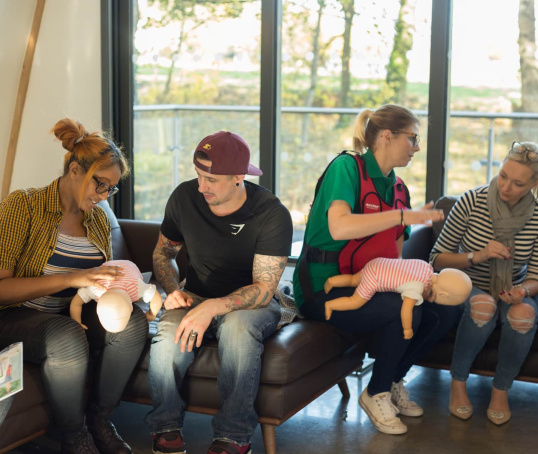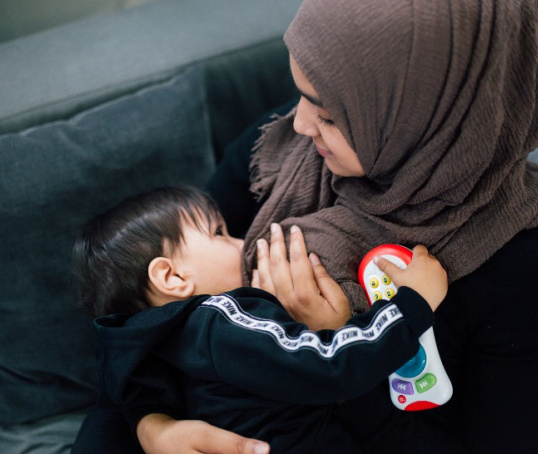Swaddling has been used in different forms throughout the world since 4000BC and around 1 in 5 babies in the UK are swaddled in the first few weeks of life (Day, 2015). Some parents say it helps their baby to sleep, reducing crying and stress, but there are risks to be aware of (Day, 2015). Here we talk about tips for safe swaddling.
What is swaddling?
Swaddling is a traditional practice of wrapping a baby up gently in a light, breathable blanket to help them feel calm and sleepy. They should only have their body wrapped and not their neck or head, to reduce the chance of suffocation.
The idea is that being swaddled will help your little one feel snug and secure, just like in your womb.
What are the benefits of swaddling my little one?
Some people say that swaddling seems to help their little one to settle more easily and sleep for longer, others find that it can help calm their baby. Research has shown swaddling, used alongside sound and movement, to be effective at soothing crying babies (Möller et al, 2019; Nelson, 2017). It can also encourage babies to sleep deeper and for longer (Nelson, 2017).
Another study found that babies who were born early and were swaddled were calmer and had improved neuromuscular development and better muscle tone, and it soothed pain and discomfort (Sleuwen et al, 2007; Kitase et al, 2017).
What are the risks of swaddling my baby?
It has been suggested that early swaddling could affect breastfeeding if babies are prevented from having skin to skin contact during feeding. However, research has not found long-term negative effects on breastfeeding (Nelson, 2017; Kelly et al, 2017).
Some people have questioned if encouraging a baby to sleep more deeply at night is beneficial for them as being asleep for longer periods reduces the time they are awake, interacting with and learning from their environment (St James-Roberts, 2012).
Natural positioning
Some evidence suggests that tightly swaddling a baby's hips could increase their chance of developing hip dysplasia (a developmental problem with a baby’s hip joint) (Clarke, 2014; Nelson, 2017). Making sure your baby's legs have enough space to be able to bend up and out at the hips allows for the natural development of the hip joints (Clarke, 2014).
Is swaddling my baby safe?
Swaddling presents a very low risk for babies, if you follow safe sleeping and hip friendly swaddling guidance (Nelson, 2017; McDonnell & Moon 2017). Current baby sleeping advice is to always lay your little one down to sleep on their back and avoid front or side positions for sleep, particularly if your baby is swaddled (Pease et al, 2016). In addition, you should stop swaddling your baby when they show the first signs of rolling over (Nelson, 2017).
What safety points do I need to consider?
Follow these seven safe and hip friendly swaddling tips:
- Consider your baby's temperature and their environment to prevent overheating. Check their temperature regularly and make sure they are wearing suitable clothes for the weather. Do not swaddle them if they are unwell or have a fever (Lullaby Trust, 2021).
- Swaddle your baby using thin materials such as a small, cotton sheet or muslin square. Do not place any additional material on top of a swaddled baby, for example a blanket which could cause them to overheat. Follow safe sleep guidance, laying your baby on a firm, flat surface clear of any other items (The Lullaby Trust, 2021).
- Don't swaddle your baby above their shoulders – their neck and head should never be swaddled. Ensure any material is secure and won't come loose as your baby moves, to avoid suffocation (The Lullaby Trust, 2021).
- Use hip-healthy swaddling techniques to reduce the chance of hip dysplasia. Make sure your baby is able to move their hips and knees freely to kick. Your baby’s legs should be able to fall into a natural position (like frog legs) rather than straight down.
- Always put your baby to sleep on their back. Never put a swaddled baby to sleep on their front or side (The Lullaby Trust, 2021; McDonnell & Moon, 2017; Pease et al, 2016; Nelson, 2017).
- If you use a swaddle product or blanket check that it conforms to safety standards and is well fitted, without fault or damage. Follow the manufacturers guidance on age or weight ratings and consider using a lower tog rating to minimise overheating risks (McDonnell & Moon, 2017; The Lullaby Trust, 2021).
- If someone else looks after your baby, make sure they also know about safe sleeping advice and how to swaddle safely. Take your time to show them and explain safe swaddling and make sure they know to always put your baby to sleep on their back (The Lullaby Trust, 2021).
How long can I safely swaddle my baby for?
Swaddling should only be introduced when your baby is a newborn. As soon as they show signs that they’re learning to roll over or they can already roll over, you need to transition them away from swaddling (Pease et al, 2016; The Lullaby Trust 2021; McDonnell & Moon, 2017; Nelson, 2017).
For more about how to swaddle your baby read our step-by-step guide to swaddling.
This page was last reviewed in December 2021.
Further information
Our support line offers practical and emotional support with feeding your baby and general enquiries for parents, members and volunteers: 0300 330 0700.
You might find attending one of our NCT New Baby courses helpful as they give you the opportunity to explore different approaches to important parenting issues with a qualified group leader and other new parents in your area.
Safer sleep advice and bereavement support from the Lullaby Trust.
Clarke N. (2014) Swaddling and hip dysplasia: an orthopaedic perspective. Archives of Disease in Childhood (99)5-6. Available from: http://dx.doi.org/10.1136/archdischild-2013-304143
Day L. (2015) The history, benefits and risks of swaddling babies. Journal of Health Visiting 3:4, 202-208. Available from: https://doi.org/10.12968/johv.2015.3.4.202
Eline L. Möller, Wieke de Vente, Roos Rodenburg (2019) Infant crying and the calming response: Parental versus mechanical soothing using swaddling, sound, and movement, PLoS ONE 14(4). Available at https://journals.plos.org/plosone/article?id=10.1371/journal.pone.0214548. [Accessed 12th December 2021]
Kitase Y, Sato Y, Takahashi H, Shimizu M, Ishikawa C, Yamamoto H, Hayakawa M. (2017) A new type of swaddling clothing improved development of preterm infants in neonatal intensive care units. Early Hum Dev. Available from: https://pubmed.ncbi.nlm.nih.gov/28675824/ [Accessed 21st December 2021]
Kelly B, Irigoyen M, Pomerantz S, Mondesir M, Isaza-Brando N. (2017) Swaddling and Infant Sleeping Practices. J Community Health Feb;42(1):10-14. Available from: https://pubmed.ncbi.nlm.nih.gov/27393144/ [Accessed 21st December 2021]
McDonnell E, & Moon R. (2014). Infant deaths and injuries associated with wearable blankets, swaddle wraps, and swaddling. The Journal of pediatrics, 164(5), 1152–1156. Available from: https://www.ncbi.nlm.nih.gov/pmc/articles/PMC3992172/ [Accessed 12th December 2021]
Nelson A. (2017) Risks and benefits of swaddling healthy infants: an integrative review. CAN Am J Matern Child Nurs. 42(4): 216-225. Available from: https://doi.org/10.1097/NMC.0000000000000344 [Accessed 12th December 2021]
Pease AS, Fleming PJ, Hauck FR, Moon RY, Horne RS, L'Hoir MP, Ponsonby AL, Blair PS. (2016) Swaddling and the risk of sudden infant death syndrome: a meta-analysis. Pediatrics. 137(6) available from: https://pubmed.ncbi.nlm.nih.gov/27244847/[Accessed 12th December 2021]
The Lullaby Trust (2021) Safe swaddling. Available at: https://www.lullabytrust.org.uk/safer-sleep-advice/swaddling-slings/ [Accessed 13th September 201812th December 2021].
Sleuwen B, Engelberts A, Boere-Boon M, Kuis W, Schulpen T, Lhoir M (2007) Swaddling: A Systematic Review Available from: https://www.researchgate.net/publication/5935787_Swaddling_A_Systematic_Review [Accessed 21stDecember 2021]
St James-Roberts I (2012) The Origins, Prevention and Treatment of Infant Crying and Sleeping Problems. Routeledge: New York.






